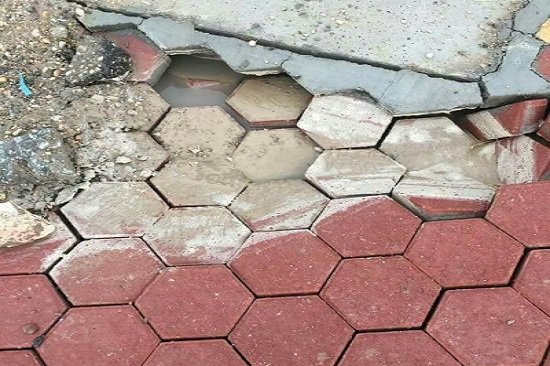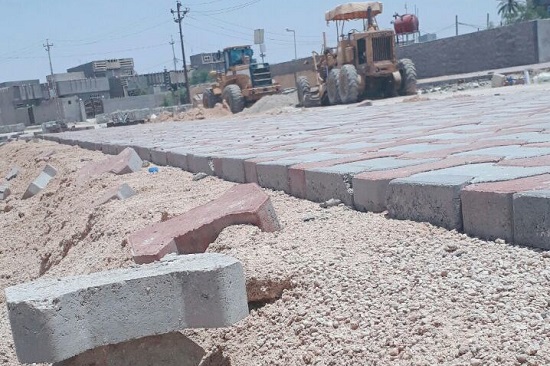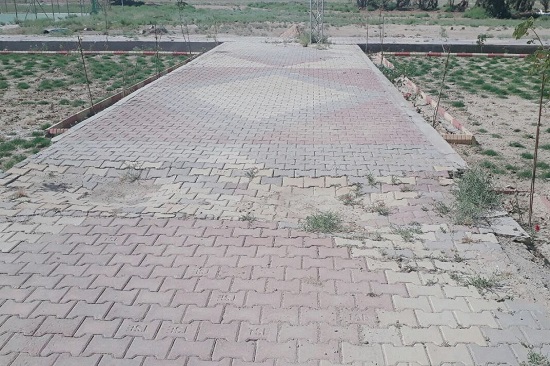| News Details |
Study of the errors of the implementation of the concrete in Iraq
2022-09-13

Assistant Instructor Salah Sabbar Thmail
University of Anbar – The Upper Euphrates Basin Development Center
The first to use the concrete were the Dutch in 1950 but spread rapidly to Germany, Canada, Australia, Belgium and France. It is used in the inner streets of cities, at intersections, bus stations, garages, train stations and in markets, because of its great importance in today's world in terms of design age compared to asphalt tiling as well as the aesthetic of the view.
The production of the concrete increased annually in the Netherlands, where the production of the concrete in 1976 to 1978 was from 13.8 million square meters to 18.8 million square meters. The concrete material is consisting of broken stones, sand and cement, and the upper layer consists of small soft materials. The concrete can be brushed in two ways, the first is the manual method, which is traditional and the most common, and the second method is the mechanical method of brushes. One of its advantages is its light weight as it can be lifted by hand to replace any piece easily and there is no need to cut the entire road in the event of the construction of a water pipe or power line compared to asphalt tiling, and it is noticeable that the use of the concrete in Iraq in the access of pavements and little we see is used for roads.
Steps in the process of implementing the concrete:
1. Subgrade natural earth layer: The natural earth must be well bordered and using adhesive skidders.
2. Subbase gravel layer: The thickness of the layer must be 20 cm of well compacted and the type of gravel used is a C class that conforms to the Iraqi general specifications of roads and bridges.
3. Bedding red sand layer: The type of sand used must be red sand with a range of 4.5 mm and 0.15 mm and the thickness of the sand layer used must be between (20 mm - 50 mm) the less thick the layer of red sand the less likely the precipitation situation in the concrete, while when the thickness of the red sand layer increases this will lead to precipitation and deformation in the concrete when vehicles pass the headquarters implementation places as we see today in the projects currently implemented, as most projects. The thickness of the sand layer is more than 15 cm and this is a big mistake in addition the moisture content of the sand used must range from (4% - 8%).
4. Concrete block paving: The concrete is made in different sizes in terms of thickness there is a measure of 6 cm, 8 cm and 10 cm according to the type of use as the thickness of 6 cm is used for pedestrians and motorcycles of all kinds, and the 8 cm based on the passage of medium traffic and the thickness of 10 cm is used for the passage of heavy traffic heavy vehicles. The thicker the concrete block, the stronger the friction generated between the entire surrounding blocks, giving it the advantage of cohesion when exposed to loads.
5. Joint filling sand: The thickness of the joints among the compound blocks plays an important role in the efficiency of transporting loads and converting them into horizontal loads, so the thickness of the joints between the compound blocks must be between (2—4 mm) as the smaller the thickness of the joint, the more efficient the transfer and dispersion of vertical loads. The size of the sand granules used to fill the joints should not exceed 1.18 mm and 20% passes through a sieve of 75 mille micron. The presence of sand granules between the joints acts on the force of friction between them and this force converts and distributes the vertical loads resulting from vehicle loads into horizontal loads distributed over the adjacent concrete blocks. Sand granules should be placed between the joints of the concretes, and the concretes should be reduced to ensure that all joints are filled with sand. Sometimes when a coarse sand is placed in which the granule size is greater than 1.18 mm, it limits the coarse granules to the top areas of the joints, preventing the soft granules from reaching the bottom of the joints and thus lacking the friction between the sand granules, which in turn reduces the distribution of vertical loads and leads to the shattering of the concrete due to the concentrated load on each piece of the them.
6. Edge restraints: The presence of the curbstone and the outer edges is very important to have the curbstone embedded at a depth up to the subbase layer of gravel to ensure that the mass of the concrete on the section of the road is further restricted. The benefits of curbstone are:
a. Prevent the crawling movements among the concrete blocks themselves.
b. Prevent the sand particles side movement from the joints of the concrete.
c. Prevent the overturning of the concrete blocks during vehicle traffic.
Below are pictures representing the implementation of concretes in some projects in Anbar province:
1. Image 1 shows the right way to implement a road in a project in Ramadi district.
2. Image 2 shows that the implementation of the concrete failed due to the lack of good reduction of the lower gravel layer.
3. Image 3 shows an expected failure to implement the concrete due to the thickness of the sand layer under the concrete for more than 30 cm.
4. Image 4 shows the failure of the implementation and descent of the concrete due to the thickness of the sand layer as well as the smashing of the edge of the supporting curbstone.
.jpg)
Image 1.

Image 2.

Image 3.

Image 4.









